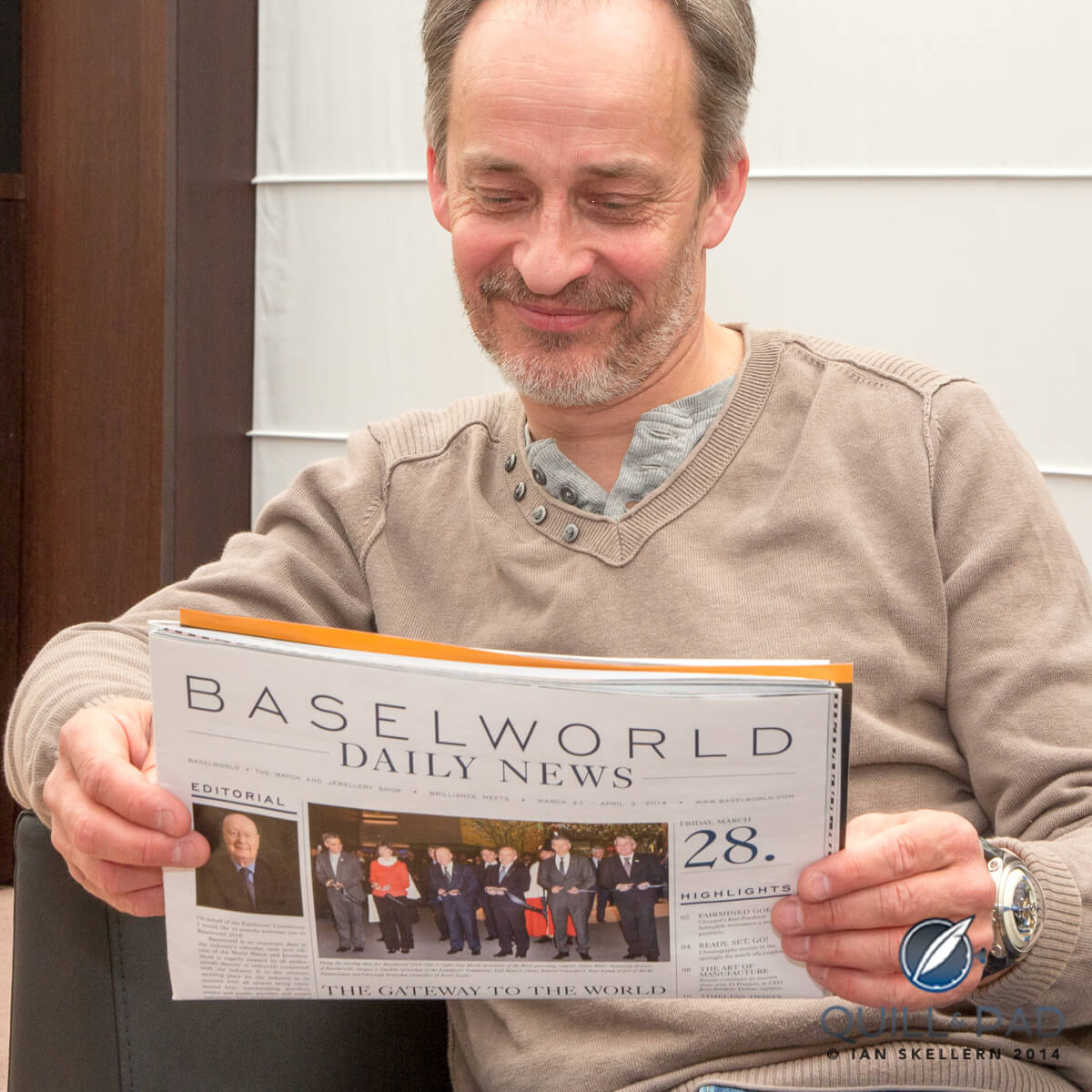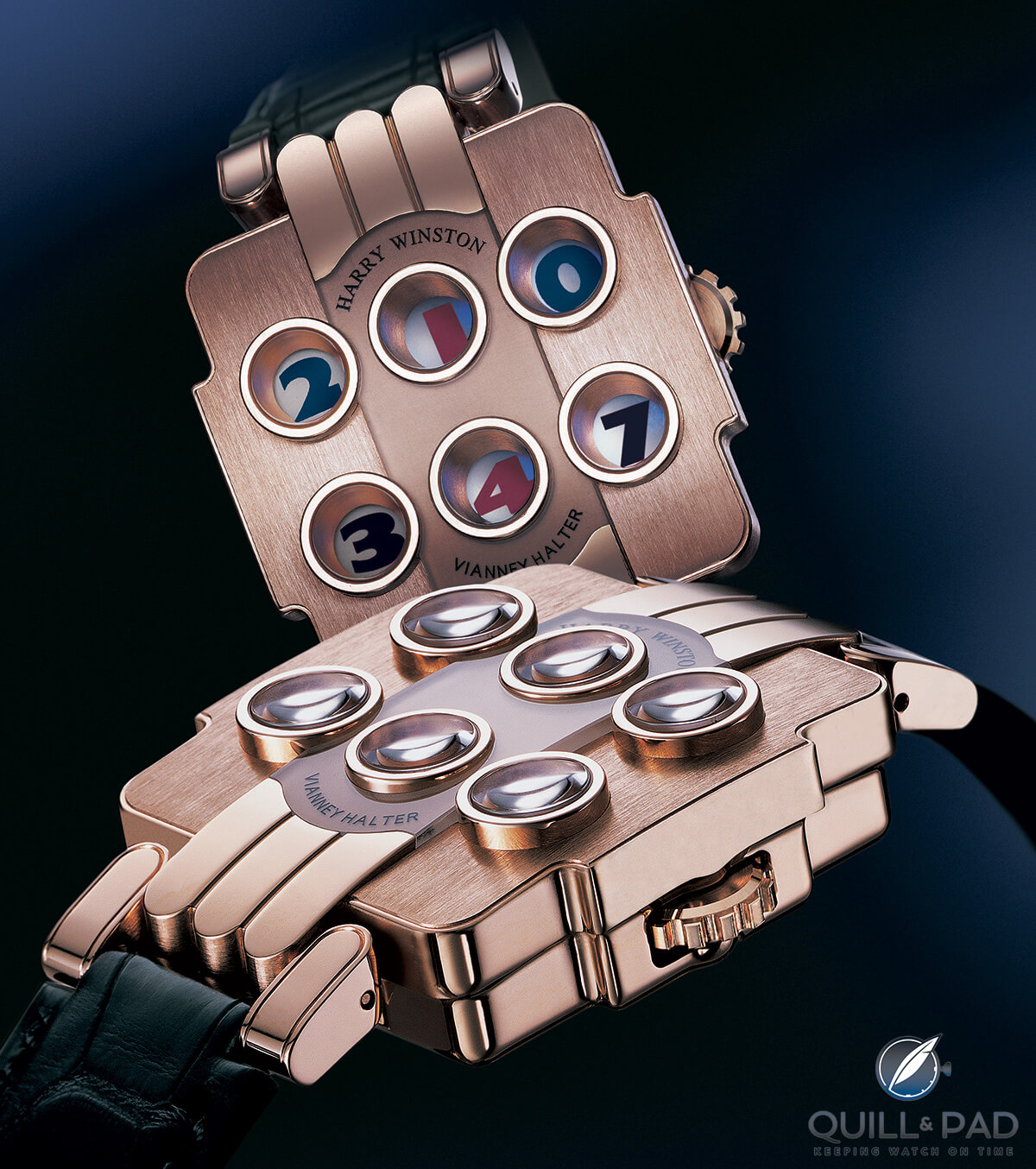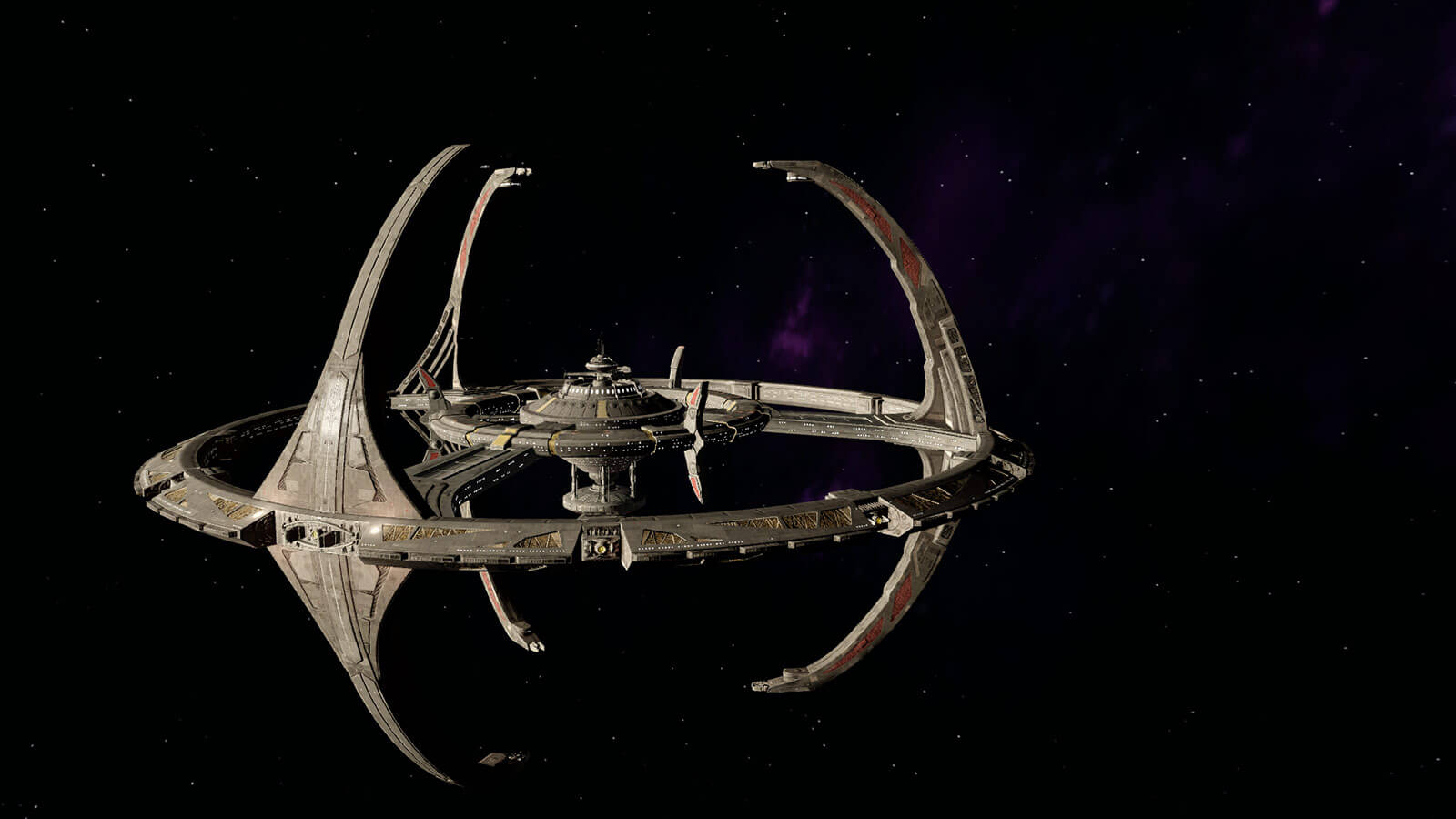The Deep Space Tourbillon, unveiled in 2013 by then 50-year-old Vianney Halter, is a watch that looks like no other and has a story like no other. A Herculean timepiece with a triple-axis tourbillon at its center, peripheral hands and a sci-fi appearance, it was justly awarded the Innovation prize at the 2013 Grand Prix d’Horlogerie de Genève.

Deep Space Tourbillon by Vianney Halter
The Deep Space Tourbillon also marked the triumphant comeback of one of the single most influential and innovative horological artists of his generation.
Halter had not produced a watch in the seven years prior to it. Perhaps most strangely of all, it was Star Trek that at least partially inspired his return to the horological spotlight in 2013.

Vianney Halter wearing his Deep Space Tourbillon at Baselworld 2014
The star(t) of a new millennium
In the early years of the new millennium, Halter was hailed as the definitive new talent in the world of independent watchmaking. He had followed his friend François-Paul Journe from Paris to Switzerland in 1990, where the pair, both experts in restoring old masters, worked alongside Denis Flageollet (now De Bethune’s technical director) and other talented watchmakers in a think-tank for complicated watchmaking called THA (Techniques Horlogères Appliquées SA). THA was rivaled in those days perhaps only by the Audemars Piguet-backed APRP (Audemars Piguet Renaud et Papi).
Many of THA’s maverick watchmakers have since set out to create their own brands, Halter included. He settled in Sainte-Croix, where THA was located. THA has belonged to Carl F. Bucherer since 2007 and has become so integrated that it no longer goes by that name.
Halter established a small manufacture and named it Janvier SA after nineteenth-century watchmaker Antide Janvier, his idol.

Vianney Halter Antiqua
Halter introduced the first watch bearing his name in 1998, a daring perpetual calendar named Antiqua, which set the tone for much of his work to come. Indeed, it represented his retro-futuristic vision of the traditional marine chronometer and laid the base for a line of watches he christened “Futur Antérieur” (“future past”).
Halter had made a splash, but it was the Opus project with the then-fledgling Harry Winston Rare Timepieces that pushed him further into the limelight. Spearheaded by Maximilian Büsser, then CEO of the jeweler’s watch division, the Opus project engaged a different independent watchmaker each year to break new horological ground and was in many ways the forerunner for Büsser’s own transparently collaborative brand, MB&F.
Harry Winston Opus 3: the magnum opus
The Harry Winston Opus 3 was a turning point for Halter, Büsser, and the Opus project in general. Picking up where his own marine chronometer-inspired timepieces left off, and quite unlike anything seen before or since, the Opus 3 was a mechanical-digital masterpiece with portholes displaying individual numerals for the hours and date.

Harry Winston Opus 3 by Vianney Halter
As so often happens inside Halter’s unfathomable mind, however, things got complicated. Too complicated. The development became far pricier than originally thought, and production became seriously delayed. It would eventually take seven years, and the involvement of APRP, to complete the watch according to Halter’s original designs.
Halter also successfully completed a functional prototype of the Cabestan with designer Jean-François Ruchonnet, another highly ambitious piece of mechanics incorporating constant force provided by a futuristically styled chain and fusée, a vintage constant-force mechanism.
Crash, boom, bang
It should perhaps come as no surprise that, as a particularly gifted artist in his field, Halter’s emotional world is a bit more acutely colored than some. In essence, his creative output is effectively controlled by his temperament – like that of so many noteworthy poets, artists, and writers.
In 2007 Halter completed a contemporary rendition of a classic marine chronometer in his typically steampunk style, complete with a spellbindingly mysterious rotor and equation of time complication, which he called the Classic Janvier Sun & Moon.

Classic Janvier Sun & Moon by Vianney Halter
But Halter, like all luxury watch manufacturers, was hit hard by the 2008 financial crisis. Despite comparatively brisk sales of the model that founded the collection in 2000, the Classic Janvier, it represented a financial setback due to a price miscalculation erring in favor of the buyer. The result: his once-buzzing Janvier factory slowly became practically devoid of employees, and production ground to a halt.
“Indeed, I was exhausted, as I had produced a tremendous amount of work for years and years,” he says, recounting the elements that sent him spiraling into a period of self-doubt.
It brought on something akin to writer’s block. “During such a period, you question yourself about your work, your life, your path, your target, their meanings . . . and, at the end, the Deep Space Tourbillon was born during this transformational time.”
A new dawn through science fiction
What pulled Halter out of his funk was a rather unexpected turn of events. Without visible reason, as Halter had not launched a new watch since 2007, the 2011 jury of the Grand Prix d’Horlogerie de Genève awarded him the “best watchmaker” prize. This award could be – and obviously was – made as a tribute.
“It reloaded me, infused me with energy to work on the Deep Space Tourbillon,” he said in retrospect.

Star Trek Deep Space 9 space station (photo courtesy Gamepedia)
In fact, Halter’s inspiration for this spirited timepiece occupied a rather more ignoble place on the cultural map than the marine chronometers and historic timepieces that had previously fueled his vision. In his time of reflection, Halter had watch in its entirety the Star Trek television series Deep Space Nine. It reignited his love of science fiction and took him back to his ingrained set of ideals.
This artistic manifesto represented the triumphant comeback of one of the single most influential and innovative horological artists of our generation. And the jury of the 2013 Grand Prix d’Horlogerie de Genève understood this and awarded this exceptional timepiece with the 2013 Innovation Award. More than appropriate recognition for this Herculean timepiece.

Vianney Halter Deep Space Tourbillon on display at the ‘Watchmakers: The Masters of Art Horology’ exhibition at Maxxi, Rome
“I wanted to explore a new style instead of carrying on with the Futur Antérieur,” he explained. The Deep Space Tourbillon, therefore, is both a departure and a continuation. Like his previous timepieces, it uses an horological device from the annals of traditional watchmaking (the tourbillon), but features it in a contemporary manner.
“I had to surprise my followers, not disappoint them; this was quite a challenge, but the solution to overcome this challenge was just to work hard on it.”
2013: A Space Oddity, the Vianney Halter Deep Space Tourbillon
Halter says his Deep Space Tourbillon is not a technically oriented watch. “In my opinion, the most interesting part is the fact that the tourbillon is used in this watch not for its alleged advantages in terms of accuracy, but for a more subtle (and powerful) purpose.”
He uses the triple-axis tourbillon as a type of kinetic sculpture “that is likely to translate the conceptual idea of the three dimensions of Euclidean space, surrounded by the fourth dimension (time).”

The Deep Space Tourbillon by Vianney Halter
In fact, he sees the triple-axis tourbillon as a type of kinetic sculpture that inspires far bigger ideas than mere accurate timekeeping. The tourbillon’s three simultaneous rotations (40 seconds, 6 minutes, and 30 minutes), ringed by the dial, take a philosophical idea and make it literal.
Here’s how it’s constructed: the large, central, triple-axis tourbillon is firmly ensconced within a patented cradle supported from the bottom only on one single ball bearing. With this core concept, it had to remain light so as minimize its energy requirements. The movement, with peripheral hands curving over the ring of the dial, was then designed around this mechanism and placed underneath a highly domed sapphire crystal.
The result was an haute horlogerie watch with the look of a UFO – and noticeably of the space station in Deep Space Nine – with a 46 mm case in lightweight titanium.
“The target of the Classic Janvier was a kind of tribute to Antide Janvier and also to show the level of my work,” Halter told me. “And the target of the Deep Space Tourbillon is a way to share my philosophy.”
2018: Vianney Halter Anniversary Watch
Celebrating 20 years since his first watch, the Antiqua, was introduced at Baselworld 1998, Halter brought out his Anniversary Watch at Baselworld 2018. It is a tribute, though, to his Classic model of the year 2000.

The original Vianney Halter Classic
While the Antiqua was a rather shocking watch for 1998, definitely breaking norms of the era, the Classic was more toned down in its approach. There were steampunk elements of it, however, that either grabbed your immediate attention or turned you right off. Both of these watches elicited very strong emotional responses.

Anniversary by Vianney Halter
The Anniversary captures a lot of what made the Classic so great but updates these elements for the modern watch-buying public. One such modification is the case size: while the original was a then-classic 36 mm, the 2018 limited edition version is 38 mm.
Another is the case material: today’s feel for the casual durability of stainless steel is a big draw, and the Anniversary obliges even if it was never Halter’s own style to use this material.
One major element of Halter’s early work was the gold rivets that adorned his watches’ crowns. The newer Anniversary retains the rivets, but not so many of them as the crown is wider, lower, and somewhat flatter, thus only able to accommodate one row of rivets as opposed to the two of his earlier work.
Among other cosmetic details that combine to make this watch eminently recognizable as an homage, yet slightly updated for the modern era, there is also the matter of the movement. While the use of Halter’s signature sapphire crystal mystery rotor is retained, the movement revealed underneath is a new one: Caliber U30A has a slower beat rate of 3 Hz and an upgraded 56-hour power reserve as compared to the Lémania-based Caliber VH100 in the original Classic.

The movement side of Vianney Halter’s Anniversary
Halter sourced this very attractive movement from a fellow AHCI member, who many of us believe to be Andreas Strehler. Surrounding the view of the movement on the case back bezel is a curious inscription: for the message to be decoded, each watch carries one-twentieth of an encrypted message that must be combined with the similar messages on the other 19 watches in this limited edition .
Halter has recently said that he is working on a new watch yet to be unveiled. So stay tuned because who knows what it could be. Only he does, and he’s not saying.
For more information please visit www.vianney-halter.com/the-watches.
Quick Facts Vianney Halter Anniversary
Case: 38 x 9.5 mm, stainless steel with 18-karat gold rivets
Dial and hands: two-level silver dial with frosted and polished finishing and blue or black printed numerals, logo, signature, and indices; polished or blued steel hands
Movement: automatic Caliber U30A; 56-hour power reserve; 21,600 vph/3 Hz frequency; sapphire crystal disk mystery rotor with encrypted code on outer periphery
Functions: hours, minutes, central seconds
Limitation: 20 pieces
Production year: 2018
Price: original retail price €54,000 including VAT; recent auction price (Phillips, June 2020) CHF 47,500
Significant watches by Vianney Halter
Antiqua (1998)
Halter’s first independent watch was a perpetual calendar and the founding piece in his Futur Antérieur line, his vision of a modern-day marine chronometer. Its case alone comprised nearly 100 individual components, including solid gold rivets.

Vianney Halter Antiqua
Quick Facts Vianney Halter Antiqua
Case: yellow gold, pink gold, white gold, platinum; one gem-set platinum case, 46.5 x 42.5 mm (including lugs and crown), underlying round case 36 mm
Dial: hand-engraved platinum dials (yellow and pink gold cases); platinum, yellow gold, and pink gold dials (platinum and white gold cases
Movement: automatic Caliber VH 198 with 35-hour power reserve
Functions: hours, minutes; instantaneous perpetual calendar with day, date, month, and leap year cycle
Production years: 1998 to 2016
Price: most recent auction price 500,000 HKD (approx. $65,000) for white gold, December 2015
Harry Winston Opus 3 (2003)
A simultaneous triumph and disappointment for the watchmaker, the Opus 3 remains the most mysterious, magical, and meaningful of Halter’s creations. Six “portholes” reveal a digital display of the hours, minutes and date, with the last four seconds of each minute counted down. The blue daytime hour numerals differentiate from the night-time numerals, which are hollowed out. At midnight the date numerals jump instantaneously, along with the minutes and hours. Limited to just 55 pieces, owners had to wait more than seven years to take delivery.

The Harry Winston Opus 3 by Vianney Halter
Quick Facts Harry Winston Opus Three
Case: 36 x 52.5 x 13.7 mm, platinum or pink gold (25 pieces each), 5 pieces in platinum set with baguette- and brilliant-cut diamonds (4.44 ct)
Movement: manually wound movement with two separate gear trains and twin spring barrels
Functions: digital display of hours, minutes (countdown of last four seconds to jump), seconds; date (countdown of last four seconds to jump), day/night indication
Limitation: 55 pieces
Price: original retail price $80,000
Classic Janvier Moon & Sun (2007)
An homage to Halter’s favorite watchmaker, Antide Janvier, the first version of this watch was limited to just 12 pieces in platinum. Containing both moon phases and the elusive equation of time, it was outfitted with a transparent rotor for automatic winding that nonetheless allowed full view of the lovely mechanics.

Classic Janvier Moon & Sun by Vianney Halter
Quick Facts Vianney Halter Classic Janvier Moon & Sun
Case: platinum, 40 x 12.5 mm
Movement: automatic Caliber VH 110 with 40-hour power reserve, 28,800 vph/4 Hz frequency
Functions: hours, minutes, seconds; annual calendar, lunar calendar, moon phase, running equation of time
Production years: 2007 onward
Price: most recent auction price 500,000 HKD (approx. $65,000) for white gold, December 2015
Deep Space Tourbillon (2013)
Halter’s comeback watch, this triple-axis tourbillon revealed an entirely new style for the independent watchmaker as well as the use of a new case material for him: titanium. It is possible that the Deep Space Tourbillon heralds an entirely new future for the watchmaker.

Vianney Halter Deep Space Tourbillon
Quick Facts Vianney Halter Deep Space Tourbillon
Case: 46 x 48 x 20 mm, grade 5 titanium
Movement: manual winding Caliber VH113 with central triple-axis tourbillon, 3 Hz/21,600 vph frequency, 60-hour power reserve
Functions: hours, minutes
Price in 2019: 241,500 Swiss francs (without shipping and taxes)
You may also enjoy:
Behind The Lens: Vianney Halter Anniversary
Why I Bought It: Vianney Halter Deep Space Tourbillon
Why I Bought It: Vianney Halter Antiqua
Behind The Lens: Twice The Fun With Two Vianney Halter Antiquas
You Are There: Visiting The Vianney Halter Workshop





















































Leave a Reply
Want to join the discussion?Feel free to contribute!